Menus
- V4 superbikes in comparison test
- Grinning and bewilderment in constant change
- Ducati louder when standing, Aprilia when driving
- Why is that?
- Fully equipped with the electronics – more is not possible!
- Brake feel better on the Duc
- Special towing methods to save the V-Day
- Conclusion
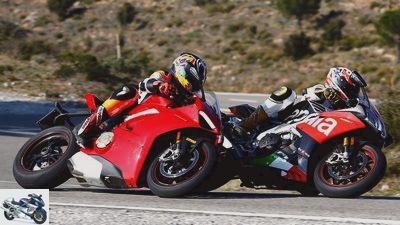
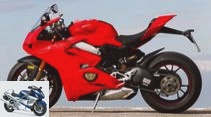
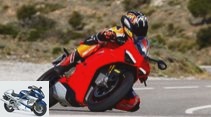
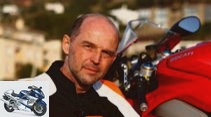

21st photos

1/21
Ducati Panigale V4 S and Aprilia RSV4 RF in comparison test.

2/21
Otherwise, the V4 RR adopts the concept of the normal Ducati Panigale V4 S..
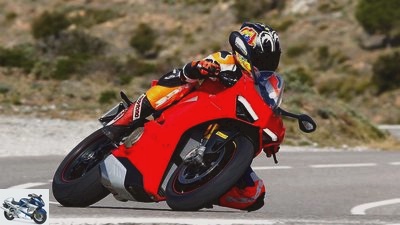
3/21
The Duc enters the race with an insane power-to-weight ratio of around 1.1 hp per kilo.
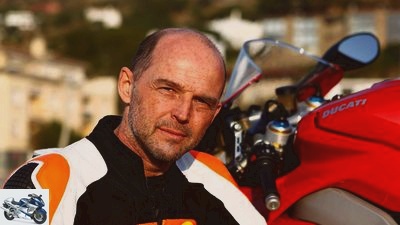
4/21
“With its incredible power-to-weight ratio, the Panigale V4 S opens a new chapter in series motorcycle construction” Volkmar Jacob, tester and car
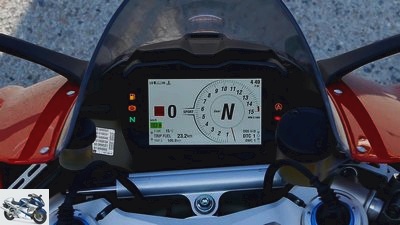
5/21
Great readability thanks to TFT technology. In addition, the cockpit offers all kinds of information.
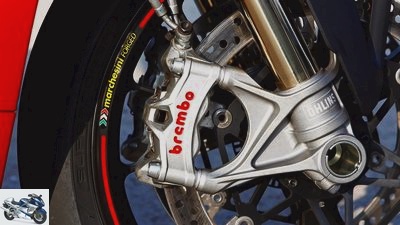
6/21
The new Brembo “Stylema” calipers contribute to the top performance of the stoppers. For the time being, the parts are exclusively on the Panigale V4.
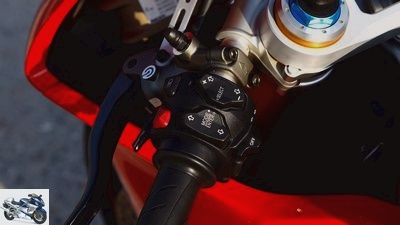
7/21
Switches with the best haptics, the menu navigation is also very well thought out – not a matter of course with the wealth of data and setting options.
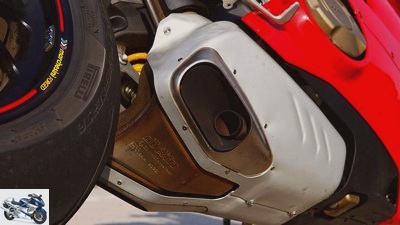
8/21
Huge collector with two outlets, perfectly hidden under the engine and swing arm.
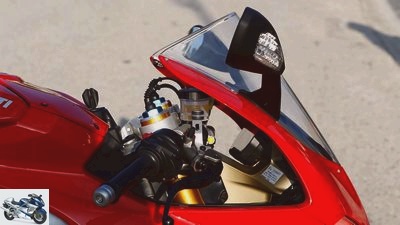
9/21
The strongly curved windshield (“bubble”) offers superb wind protection, especially when you are racing.
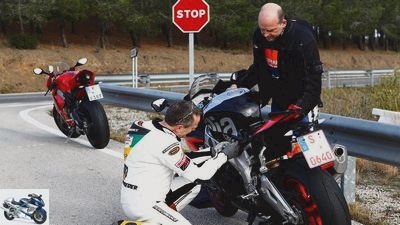
10/21
Road signs as providence? A loose plug contact on the side stand switch temporarily paralyzed the RSV.
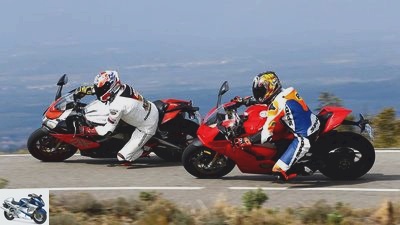
11/21
During the test there was a constant change of grins and bewilderment.
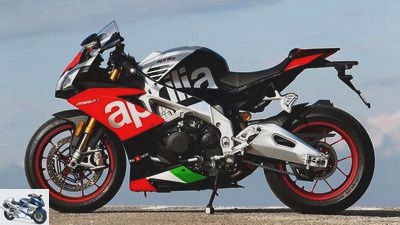
12/21
The Aprilia RSV4 RF.
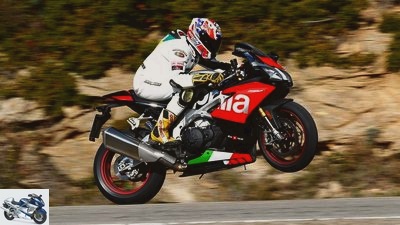
13/21
Due to the low speed level (max. 14000 / min), the Aprilia always has to be driven one gear lower than the Duc in attack mode.
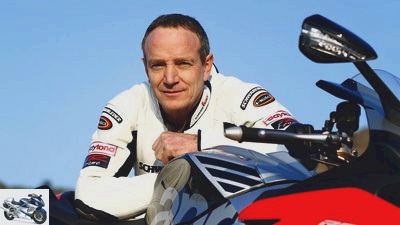
14/21
“Awesome chassis of the Aprilia. No other series-produced bike is closer to a real racing motorcycle. ”Achim Steinmacher, racer and tester
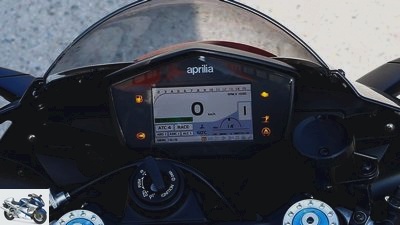
15/21
TFT technology and good readability also with the Aprilia display. Nice feature: display of the incline.
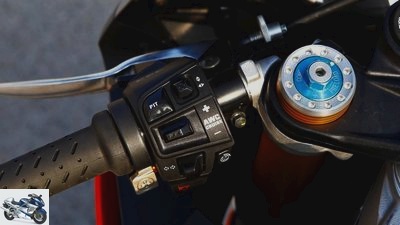
16/21
The four-way switch at the top right turned out to be very delicate, requested information is often a matter of luck.
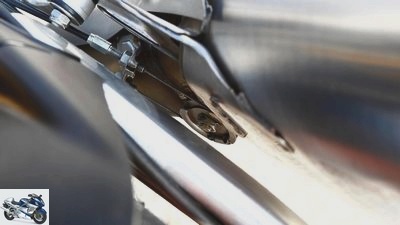
17/21
Electromechanically controlled exhaust flap. When the passage is fully open, the RSV thunders disproportionately loud.

18/21
A bench on top quality asphalt, the basic set-up of the shock absorber was too tight for bumpy slopes.
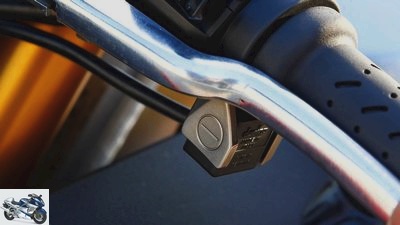
19/21
Still annoying: If the clutch lever is in an ergonomically comfortable position, it actuates the traction control switch when it is pulled: unintentional deactivation of the TC is possible.
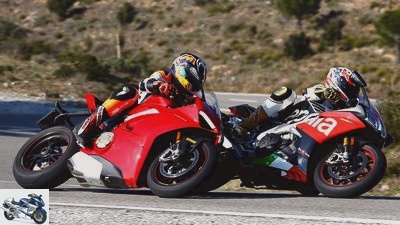
20/21
Close duels on country roads, wheel-to-wheel action of the V4 bikes.
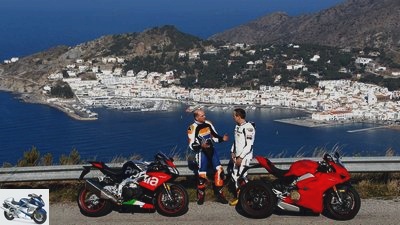
21/21
Who makes the race …? Ducati on 1, Aprilia on 2. However, there is no real loser.
Ducati Panigale V4 S and Aprilia RSV4 RF
V4 superbikes in comparison test
Content of
Like an invasion, the brand new Ducati Panigale storms into the V4 segment of superbikes that Aprilia has ruled alone until now. But who will win the group test? Ducati Panigale V4 S or Aprilia RSV4 RF?
The two Italians chase wheel to wheel along the perfectly curved road in the northern Spanish province. The D.ucati Panigale V4 S shoots ahead, the Aprilia RSV4 RF lurks in the rearview mirror, filling the format. Today it is, today it is decided which V4 hammer will reap the winning laurel and which will bear the shame of the second winner. The dispute over Italian supremacy is entering a new round. It has been around since the late nineties, when Aprilia launched its first superbike, the RSV Mille. Since then, the two works have been considered favorite enemies and persistently fight mercilessly.
Buy complete article
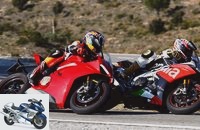
Ducati Panigale V4 S and Aprilia RSV4 RF
V4 superbikes in comparison test
Can this power be mastered at all??
This year, at least the paper version speaks for the revolutionary Duc, which praised the insane 214 HP at just 195 kilos when fully fueled (factory information). The result is a power-to-weight ratio of around 1.1 hp per kilo – world record number one for series bikes! A mixture of anticipation and nervousness determines the emotional life of the testers: Can this power be controlled at all? The Aprilia with 201 hp and 204 kilos (also factory specifications) competes in a somewhat more moderate duel. Still dream values, but their power-to-weight ratio is over ten percent lower than the Ducati. The champion is already determined?
During the test there was a constant change of grins and bewilderment.
The two quadruplets rumble dully while standing at idle speed. The new sound of the Ducati mingles with the familiar 65-degree V4 grumble of the Aprilia. Because of the crank pin offset of 70 degrees, and therefore equipped with an asymmetrical firing order, the Duc does not purr like a typical 90-degree V4. But it thunders just as little as in V2 times. Rather, it sounds like a mix of both: different, unusual, new. Of course, the strong rumble remained, at least at low speeds. Those who love the noise are guaranteed to appreciate the new drive. Anyone who has listened critically to the rumble and hoped for groundbreaking changes could be disappointed. Especially since the V4 jerks sullenly with gas commands below about 2,500 rpm despite smaller individual cubic capacities. Nonetheless, it really gets going, and with increasing revs the 1100 turns into a wonderfully refined engine that now creates typical V4 vibes and sounds the same – well, it works!
Grinning and bewilderment in constant change
It is difficult to describe which fire the propellant ignites with its measured 215 hp in the five-digit range. The Pani pushes and pushes like the devil, continues to power, on and on and shoots its driver into unimagined dimensions. Grinning and bewilderment in constant change. Even at 150 km / h in second gear, the front wheel still strives towards the stars without the aid of the clutch. Short break, let the performance sink in. A look at the driving performance attests the Ducati a value of zero to 200 km / h in 7.1 seconds. It runs three tenths faster than the Aprilia, but it doesn’t break the record. To do this, she would have to accelerate in less than seven seconds, which she could safely do, but deny her the heavily jarring clutch at racing starts. Did Bologna undersize the part? Further tests have to show that. In normal use, however, the clutch works flawlessly.
The Duc enters the race with an insane power-to-weight ratio of around 1.1 hp per kilo.
Just like the pull-through exercise from 50 to 150 km / h in sixth gear, which the Panigale completes in an unbelievable 6.9 seconds: production bike world record number two! And another clear indication of the immense punch that the V4 delivers. Furthermore, the high-revving engine scratches the 15,000 / min mark, an unmatched value to date, at least for superbikes. Overall, the drive undoubtedly opens a new chapter in series engine construction. “Shifting”, critics now shout loudly, “with over 1100 cubic meters, the power output is no feat.” A justified objection, because converted to one liter of displacement, the Duc “only” lifts 195 horses, five fewer than the Aprilia test machine, the presses exactly 200 HP on our test stand. Will the entire competition soon be upgrading in terms of displacement? In any case, she is now under pressure.
Ducati louder when standing, Aprilia when driving
Meanwhile, we leave the discussion of fair or unfair to opponents and supporters of the respective drive and prefer to return to the facts. For example, the fact that the RSV4 always has to be driven one gear lower in attack mode than the Ducati, which serves its punch extremely confidently. This is due to the overall gear ratio of the Aprilia, which the designers chose to be correspondingly long due to the lower speed level (maximum speed 14,000 / min).
Due to the low speed level, the Aprilia always has to be driven one gear lower than the Duc in attack mode.
From around 4,500 rpm, excessively loud rumbling thunder accompanies the goings-on. From this brand on, the exhaust flaps open completely, which means that the silencer no longer fully deserves its name. That may be in accordance with the law, but it is not particularly socially acceptable. “The Ducati is significantly louder when stationary, the Aprilia when driving,” says colleague Steinmacher in a nutshell. After all, the RSV conveys a pure V4 feeling with sound and beat. In addition, despite its lower punch, it cannot be left behind, on the contrary. “At Aprilia, I will stay with you,” said said colleague with a smile. “Conversely, I have to stretch myself a lot with the Ducati so as not to let it tear off.”
Why is that?
Mainly on the terrain, because the Ducati can hardly implement its additional power on the country road. This works at best on long straights or on the motorway. On the preferred playground – curvy stretches of all kinds – other characteristics such as handling, feedback, precision count. The RSV4 RF is here. The Duc also masters the shooting formidably and steers lightly, hits the desired line and moves steadily in circles. But it does not come close to the unearthly imagination of the Aprilia: Think curve, bend, pull through, done. In doing so, she reports precisely from the road; even more direct feedback from the front wheel is hard to imagine. In addition, the RSV is inclined like the proverbial board and, if necessary, draws the radii as narrow as you like – racing feeling at it’s very best! And the catch? There is none. At least not on a flat track. If furrows come into play, however, things are a little different. The conventional chassis, especially at the rear, is clearly too tight for mogul slopes. Opening the damping completely brings relief, but even with this the shock absorber only absorbs bumps to a limited extent. In other words: The RSV driver has to endure the stumbling on lousy asphalt.
Road signs as providence? A loose plug contact on the side stand switch temporarily paralyzed the RSV.
The V4 S does that much better with its electronically controlled, semi-active chassis. The fork and shock absorber are also designed to be quite tight at the factory, especially in the “Sport” and “Race” modes. But the suspension elements can either be adjusted to be harder or softer while maintaining the semi-active control (“Custom Dynamic Suspension”). Changes can also be saved as a fixed setting (“Custom fixed suspension”), a kind of electronic click. In the setup tips in the data box, we decided on the latter variant. However, the system offers a wealth of setting options for those who like to experiment. Also because the electronics allow separate settings for braking, when negotiating bends and for accelerating out if required. Practical: If you get lost, the “Default” menu item resets the values to the factory settings.
Fully equipped with the electronics – more is not possible!
Like all modern super athletes, our two opponents also offer numerous electronic driving aids: ABS, traction and wheelie control, different driving modes, choice of throttle response or power delivery, automatic gearshift. Both the Aprilia and the Ducati have these features on board, and of course they can all be adjusted several times. The Bologna bike also offers an adjustable motor brake and slide control. The latter is supposed to keep the V4 S reliably on track when braking – crazy!
TFT technology and good readability also with the Aprilia display. Nice feature: display of the incline.
From this pool we pick out two systems in which we noticed major differences between the bikes. On the one hand, this concerns the wheelie control. The Duc offers eight different levels, which either intervene early (positions 6 to 8) or late (levels 1 to 3). 4 and 5 form something in between, with position 5 being perfect for the first attempts of future wheelie specialists. The RSV4, on the other hand, only offers three levels, which, in contrast to the gentle interventions of the Ducati, regulate roughly and bring the front wheel back to the ground. In addition, there are hardly any noticeable differences between the settings.
Brake feel better on the Duc
The Noale athlete, on the other hand, has advantages with the number two driving aid, the automatic gearshift. In contrast to the Ducati Quickshifter, which also refused to work at the end of the test, the system enables clutch-free downshifts even when the gas is open. A great quality if you have chosen a gear that is too high when overtaking. As already mentioned several times in previous tests, the following applies to electronic helpers in general: approach your preferred setting from the early stages.
The new Brembo “Stylema” calipers contribute to the top performance of the stoppers. For the time being, the parts are exclusively on the Panigale V4.
Speaking of keys. The term leads us straight to the brake section. The Ducati anchors convey a feeling of the extra class. The brand new “Stylema” brake calipers from class leader Brembo contribute to this. Like the M50 saddles at the time, the new material is initially available exclusively on the current Ducati Superbike, in this case on the Panigale V4. Your stoppers can be dosed as fine as a hair, require little hand strength, offer a high level of transparency and delay like hell – amazing! The Aprilia’s system also bites hard, but it doesn’t quite come close to the Duc’s braking feel.
Special towing methods to save the V-Day
On the other hand, the RSV’s seating position is super sporty. It places its pilot very compactly. In addition, their seat protrudes 15 millimeters higher, which means that the Aprilia driver exerts more pressure on the front wheel with almost the same handlebar height. Anyone who switches from the Ducati, with its surprisingly everyday arrangement of bench, pegs and handlebars, to the RSV4, thinks they are in the middle of the starting grid for a World Superbike race.
Which V4 superbike wins the test in the end?
In terms of sport, we also saw the two not exactly everyday events in the course of the test. After just a few kilometers on the first day, the Aprilia surprised with misfiring, and finally nothing worked. The search for the cause revealed a loose plug connection of the side stand switch. Snap the connector into place, done.
Surprise number two was the Ducati. On the way to the gas station, she ran out of fuel – after 48 kilometers on reserve. The towing method “Right-foot-of-Aprilia-pilot-to-left-Raste-der-Ducati” bridged the last kilometers. Exactly 15.69 liters fit into the 16-liter barrel of the Duc. V-Day was saved!
Conclusion
1. Ducati Panigale V4 S
Their immense power combined with low weight lifts the dynamics into new dimensions. The V4 S also performs at the top level on the chassis side. The next issue shows whether your overall package also shines on the racetrack. Then the Duc has to face the entire Superbike competition!
2. Aprilia RSV4 RF
Second winner but not a loser. Handling, feedback and precision set the absolute benchmark. In addition, no other athlete conveys such a racing spirit. But the rock-hard shock absorber in particular only works on smooth surfaces.
Related articles
-
Italo athletes in comparison: Aprilia RSV4 Factory, Ducati Panigale S and MV Agusta F4 R.
www. 26th photos 1/26 Thanks to the changed installation position of the engine compared to the 1198, the Panigale now has a…
-
Comparison test BMW S 1000 RR, Ducati 1299 Panigale S and Yamaha YZF-R1
fact 46 photos fact 1/46 Yamaha YZF-R1. fact 2/46 BMW S 1000 RR. fact 3/46 The swing arm takes the wheel axle very far back – good for driving stability….
-
Comparison test Aprilia RSV4 R APRC and Ducati 1199 Panigale
fact Comparison test: Aprilia RSV4 R APRC and Ducati 1199 Panigale The best Italian superbikes in comparison The more expensive versions first – few…
-
Aprilia RSV4 RF and Yamaha YZF-R1M in comparison test
40 photos markus-jahn.com 1/40 Aprilia RSV4 RF and Yamaha YZF-R1M in comparison test. markus-jahn.com 2/40 You sit quite high on both bikes, but with the…
-
Ducati 1299 Panigale S and Ducati 1199 S in comparison test
fact 29 photos fact 1/29 The two sisters only look like identical twins at first glance … fact 2/29 The wheelbase (1437 mm), seat height (830 mm) and…
-
Ducati 1299 Panigale S and Kawasaki Ninja H2 in comparison test
31 photos 1/31 On the left in the picture 197 PS and 145 Nm (Ducati 1299 Panigale S), on the right there are 200 PS and 133 Nm…
-
Test: Aprilia RSV4 R, Ducati 1198S and MV Agusta F4
fact Aprilia RSV4 R, Ducati 1198S and MV Agusta F4 Comparison test: Italian superbikes Content of When the Aprilia RSV4 R, Ducati 1198S and MV Agusta F4…
-
fact 34 photos fact 1/34 For the 11/2015 issue of MOTORRAD, the Supersport septet rode the “Masterbike 2015” at the great Lausitzring in Brandenburg….
-
Ducati Panigale 899 and Suzuki GSX-R 750 in the test
fact 28 photos fact 1/28 Crime scene “Automotodrom Grobnik” near Rijeka, Croatia: The brand new Ducati 899 Panigale challenges the battle-savvy evergreen…
-
Comparison test Aprilia SL 1000 Falco, Ducati ST 4S, Honda VTR 1000 F, Voxan Cafe Racer
Gargolov Comparison test Aprilia SL 1000 Falco, Ducati ST 4S, Honda VTR 1000 F, Voxan Cafe Racer Sympathy hunter Dull, but subtle rumble of thunder, full…